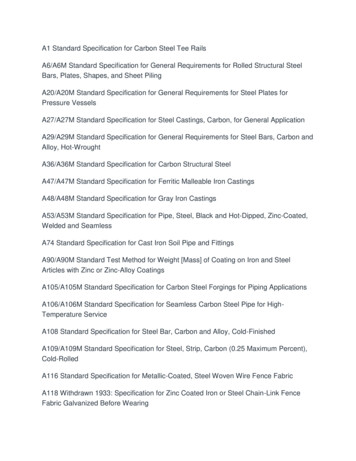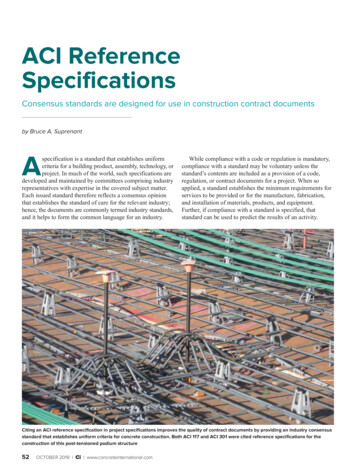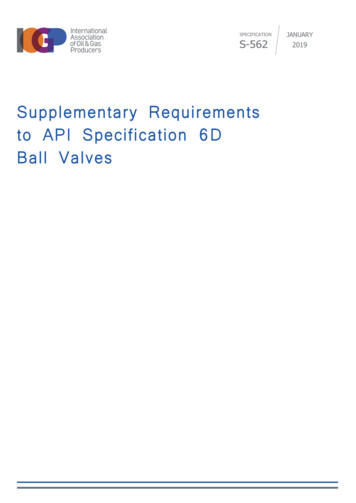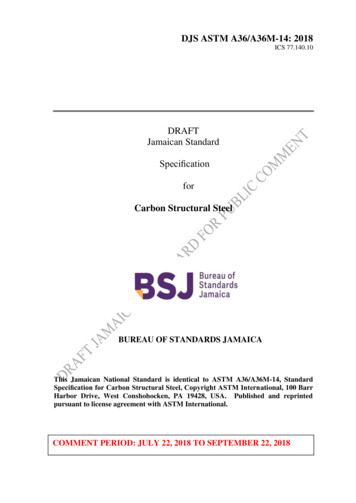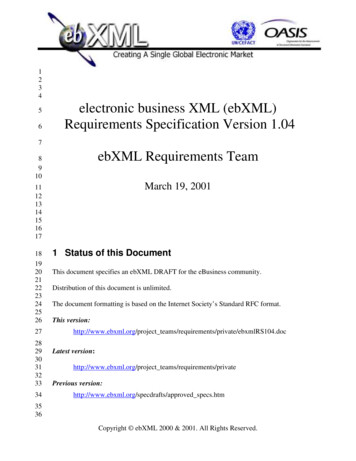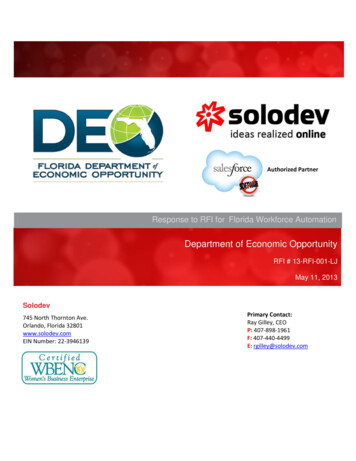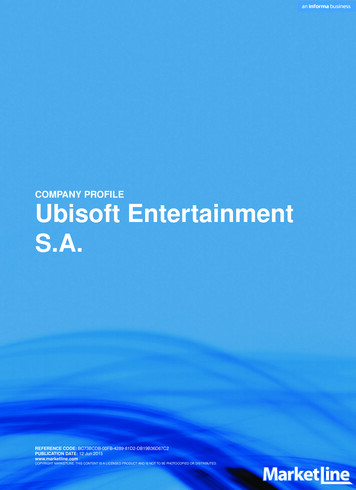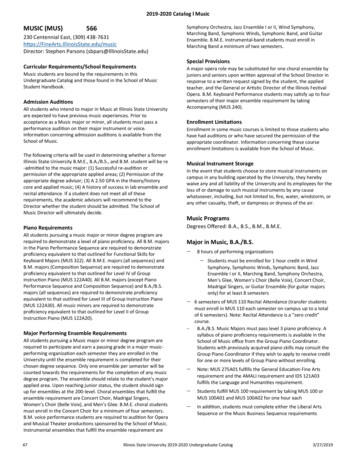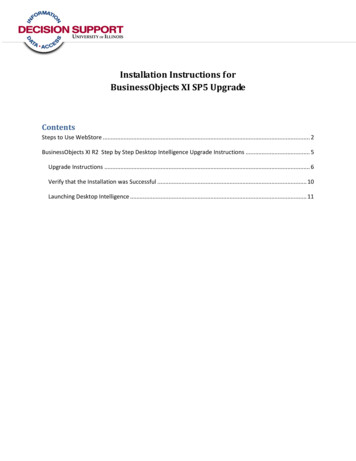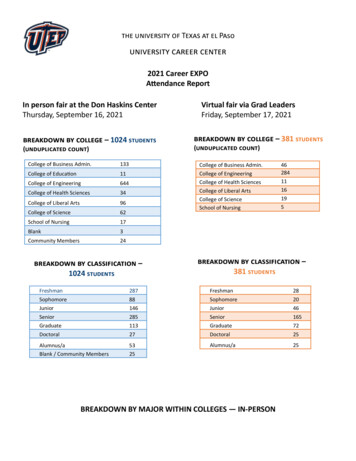
Transcription
Business Requirements SpecificationHybrid Resources Phase 2Document Version: 1.3Current Version Date: 3/7/2022Revision HistoryDateVersion3/7/20221.3Description Updated language for H.MACCBRQ035, H.MACC BRQ105, BRQ246,BRQ466, BRQ475, BRQ510, BRQ515,BRQ531, BRQ532, BRQ535, BRQ542,BRQ544, BRQ550, BRQ555, BRQ850(market sim), BRQ831, BRQ832,BRQ975, BRQ1010. Added BRQ506, BRQ1005. Deleted BRQ525, covered in newimplementation note for BRQ515. RIMS requirements moved fromPhase 2B to Future Phase (specificsto be updated in future version ofExternal BRS).Note: All updates to v1.13 are reflected inred.Copyright 2021 California ISODoc ID: GNFDMDEHU6BB-46-53Page 1 of 73
Template Version:TechnologyHybrid Resources Phase 2 Business Requirements Specification PlanningDocumentVersion:Date Created:61.35/27/2021DisclaimerAll information contained in this draft Business Requirements Specification (BRS) asprovided by the California Independent System Operator Corporation (ISO) is prepared fordiscussion and information purposes only. The draft BRS is provided “as is” withoutrepresentation or warranty of any kind, including, without limitation, a representation orwarranty as to accuracy, completeness, or appropriateness for any particular purpose.The draft BRS shall be revised as the development and review of the businessrequirements progresses. The ISO assumes no responsibility for the consequences of anyerrors or omissions. The ISO may revise or withdraw all or part of this information at anytime at its discretion without notice.Copyright 2022 California ISODoc ID: GNFDMDEHU6BB-46-53Page 2 of 73
Template Version:TechnologyHybrid Resources Phase 2 Business Requirements Specification PlanningDocumentVersion:Date Created:61.35/27/2021Table of Contents1Introduction . 51.12Purpose . 5Details of Business Need/Problem . 62.13Description . 6Business Impacts . 73.13.24Business Practice Manuals (BPM). 7Other. 9Business Requirements . 104.1Phase 2-A – A/S and HSL – Fall 2021 . 104.1.1 Business Process: N/A . 104.1.1.14.1.24.1.2.14.1.3Business Requirements .17Business Process: TBD. 184.1.4.14.1.54.1.6Business Requirements .13Business Process: TBD. 174.1.3.14.1.4Business Requirements .10Business Process: Manage Real Time Hourly Market (RTPD) . 13Business Requirements .18Business Process: Market/Business Simulation . 19Business Process: Multiple ACC . 204.1.6.1Business Requirements .204.2Phase 2-B – Spring 2022 . 214.2.1 Business Process: N/A . 214.2.1.14.2.24.2.2.14.2.3Business Requirements .36Business Process: TBD. 424.2.9.14.2.10Business Requirements .34Business Process: Short Term Forecast Reporting. 364.2.8.14.2.9Business Requirements .32Business Process: TBD. 344.2.7.14.2.8Business Requirements .30Business Process: TBD. 324.2.6.14.2.7Business Requirements .26Business Process: Publish ACC Constraint Shadow Prices . 304.2.5.14.2.6Business Requirements .25Business Process: Manage Real Time Hourly Market (RTPD) . 264.2.4.14.2.5Business Requirements .24Business Process: Manage Real Time Hourly Market . 254.2.3.14.2.4Business Requirements .21Business Process: N/A . 24Business Requirements .42Business Process: Market/Business Simulation. 44Copyright 2022 California ISODoc ID: GNFDMDEHU6BB-46-53Page 3 of 73
Template Version:TechnologyHybrid Resources Phase 2 Business Requirements Specification Planning4.2.10.1DocumentVersion:Date Created:61.35/27/2021Business Requirements .444.3Phase 2-B-1 – Multiple ACC – Spring 2022 . 464.3.1 Business Process: Multiple ACC (Master ACC, Subordinate ACC) . 464.3.1.14.3.1.24.3.1.3Business Requirements .46Business Requirements .47Business Requirements .484.4Future Phase – RIMS . 514.4.1 Business Process: N/A . 514.4.1.14.4.2Business Requirements .51Business Process: Multiple ACC (Master ACC, Subordinate ACC) . 704.4.2.1Business Requirements .705 Acronyms, Terms, and Definitions . 71Appendix: Component Table Example . 73Copyright 2022 California ISODoc ID: GNFDMDEHU6BB-46-53Page 4 of 73
Template Version:TechnologyHybrid Resources Phase 2 Business Requirements Specification PlanningDocumentVersion:Date Created:61.35/27/20211 IntroductionThis business requirements specification (BRS) supports the Hybrid Resources Phase 2 project.1.1 PurposeThe ISO launched this stakeholder initiative to identify new or enhanced market rules and businessprocesses needed to accommodate hybrid resources, resources that consist of two sets of market rulechanges that will facilitate mixed-fuel type (hybrid and co-located resources) project participation in the ISOmarkets.Prior to this initiative, Phase 1 identified a first set of modifications generally concerned with setting up andoperating co-located resources, which was approved by the ISO Board of Governors in July 2020 andimplemented on December 1, 2020.Building on phase 1, Phase 2 focuses on modifications that will explore how hybrid generation resourcescan be registered and configured to operate within the ISO market. The initiative will further developsolutions allowing developers to maximize the benefits of their resource’s configuration. Additionally,hybrid resource configurations also raise new operational and forecasting challenges that the ISO plans toaddress during this initiative.For an in-depth initiative background, reference the publically available Revised Final RevisedFinalProposal-HybridResources.pdfCopyright 2022 California ISODoc ID: GNFDMDEHU6BB-46-53Page 5 of 73
Template Version:TechnologyHybrid Resources Phase 2 Business Requirements Specification PlanningDocumentVersion:Date Created:61.35/27/20212 Details of Business Need/Problem2.1 DescriptionBusiness Opportunity/Problem Statement:What:Interest in energy storage is significant and growing as state and federalpolicy makers and regulators support energy storage development tohelp decarbonize the grid.When:This policy initiative has a Fall 2021 and Spring 2022 targetimplementation. RIMS Requirements have been moved to Future Phase(see section 4.4), refer to RUG slides for updated timeline.Why do we have this opportunity/problem:Currently the interconnection queue includes a significant volume ofmixed fuel projects.Copyright 2022 California ISODoc ID: GNFDMDEHU6BB-46-53Page 6 of 73
Template Version:TechnologyDocumentVersion:Hybrid Resources Phase 2 Business Requirements Specification PlanningDate Created:61.35/27/20213 Business Impacts3.1 Business Practice Manuals (BPM)BPMBPM Change ManagementCandidate CRR Holder RegistrationCompliance MonitoringCongestion Revenue RightsCredit Management and Market ClearingDefinitions & AcronymsDemand ResponseDirect TelemetryDistributed Generation for DeliverabilityEnergy Imbalance Market (EIM)Generator Interconnection and DeliverabilityAllocation ProceduresGenerator Interconnection Procedure (GIP)Generator ManagementManaging Full Network ModelMarket InstrumentsMarket OperationsDescription of Impact(s)No impactNo impactNo impactNo impactNo impactNo impactNo impactImpacts: Update for Hybrid resources providing telemetrydata for all VER components Updates to add clarifications to what MPs willneed to submit for hybrid resources and theunderling VER components Potential change for the High Sustainability Limit(HSL) changes.No impactNo impactNo impactNo impactNo impactNo impactImpacts: Attachment B: update for new NGR type andmaster file characteristics Potential change for the High Sustainability Limit(HSL) changes Identification of VER components Dynamic LimitImpacts:Copyright 2022 California ISODoc ID: GNFDMDEHU6BB-46-53Page 7 of 73
Template Version:TechnologyDocumentVersion:Hybrid Resources Phase 2 Business Requirements Specification PlanningBPM6Date Created:1.35/27/2021Description of Impact(s) MeteringOutage ManagementReliability Coordinator ServicesReliability RequirementsRules of Conduct AdministrationScheduling Coordinator Certification and TerminationSettlements and BillingTransmission Planning ProcessUpdate for new NGR type and master filecharacteristics Potential change for the High Sustainability Limit(HSL) changes Identification of VER components Hybrid and co-located resources must be able tobid and be awarded AS Dynamic LimitMeter data is required at the component level forboth ISOME and SCME.No impactNo impactNo impactNo impactNo impactSettlements shall exempt Hybrid Resources frombeing assessed RAAIM settlement.No impactCopyright 2022 California ISODoc ID: GNFDMDEHU6BB-46-53Page 8 of 73
Template Version:Technology6DocumentVersion:Hybrid Resources Phase 2 Business Requirements Specification PlanningDate Created:1.35/27/20213.2 OtherImpactDescription (optional)Market SimulationMarket simulation is needed for Market/SIBR, Master File, andSettlement changes along with forecasting changes that will beseen on CMRI.Market Participant ImpactMarket participants will be impacted due to the creation of thenew unit type: hybrid resources.User Acceptance Testing (UAT)UAT is required on the new Dynamic Limit functionality as well asfor the forecasting changes.Internal TrainingInternal training required for the new Dynamic Limit Tool and thenew unit type, which is different than the existing NGR model.Internal training is also needed for the forecast changes.External TrainingExternal training is required for the hybrid resource unit type andnew SIBR rules along with the Master File elections and newDynamic Limit Tool.Policy InitiativeYes VendorArchitectural Framework and RoadmapSiemens work for SIBR, IFM/RTM, EMSForecast Service Providers (FSP): will be impacted by theidentification of VER components and how they’re used by theForecasting team and the settlement of only the forecastingfee.This project will follow the recommendations as aligned within thearchitecture definition (AD).Copyright 2022 California ISODoc ID: GNFDMDEHU6BB-46-53Page 9 of 73
Template Version:Technology6DocumentVersion:Hybrid Resources Phase 2 Business Requirements Specification PlanningDate Created:1.35/27/20214 Business RequirementsThe sections below describe the Business processes and the associated business requirements involved in theproject. These may represent high-level functional, non-functional, reporting, and/or infrastructure requirements.These business requirements directly relate to the high-level scope items determined for the project.4.1 Phase 2-A – A/S and HSL – Fall 20214.1.1 Business Process: N/A4.1.1.1 Business ImpactedThe System shall be able to receive the highsustainable limit (HSL) via telemetry for each colocated VER and VER component of a hybrid.CoreEMSAt the 10-second interval, the System shallreceive the high sustainable limit (HSL) value atthe amount that the resource is capable ofproducing regardless of other constraints; e.g.,POI.CoreEMSCoreEMSID#Business FeatureHRp2BRQ001HRp2BRQ005Implementation Note: Based on currentambient conditions, the HSL should be the fullMW capability. For example: The MW output ofa site’s individual resource should be based onthe total number of solar panels or windturbines installed.HRp2BRQ010For Co-located Resources: If Telemetry of all colocated resources behind each ACC plus ASawards of all resources behind each ACC isgreater than the ACC limit, the System shallsubtract the amount exceeding the ACC limitfrom the available AS in EMS.Copyright 2022 California ISODoc ID: GNFDMDEHU6BB-46-53Page 10 of 73
Template Version:TechnologyDocumentVersion:Hybrid Resources Phase 2 Business Requirements Specification PlanningDate Created:HRp2BRQ015For hybrid resources: If Telemetry of the HybridResources plus AS awards is greater than theDynamic limit, the System shall subtract theamount exceeding the Dynamic limit from theavailable AS in EMS for that Hybrid Resource.CoreEMSHRp2BRQ020When a co-located battery has an AS award, theSystem shall account as available AS no morethan two times the available state of charge(SOC).CoreEMS61.35/27/2021Example 1:Battery has 10 MW Spin award, it needs tomaintain a SOC of at least 5 MWH. Anytime theSOC drops below 5 MWH the available Spinneeds to be reduced.If storage resource has 10 MW award and onlyhas a SOC of 4 MWH, EMS can only count 8 MWof Spin.HRp2BRQ340The System shall publish the high sustainablelimit (HSL) with a quality flag to downstreamsystems.CoreEMSHRp2BRQ345The System shall publish all hybrid resourcedata points to downstream systems.CoreEMSHRp2BRQ970The System shall sum up the state of charge perACC limits for all storage resources.CoreEMSHRp2BRQ975The System shall receive the Effective ACCLimits from RTD Market.CoreEMSCoreEMSNote: See BRQ532 for more information.HRp2BRQ950The System Resource Monitor’s new “CoLocated Resources” user interface shall bepresented (formatted) similar to the existingGeneration Data display that will includesCopyright 2022 California ISODoc ID: GNFDMDEHU6BB-46-53Page 11 of 73
Template Version:TechnologyDocumentVersion:Hybrid Resources Phase 2 Business Requirements Specification PlanningDate Created:61.35/27/2021columns: OMS Availability, Resource ID, SCID,Fuel Type, ACC ID, ACC Name, effective ACCLimit, Injection (Positive) and withdraw(negative) ACC Limit, and any current columnthat is displayed on the ‘Gen Data’ display.If the sum of the resources telemetry belong toACC group is positive then use Injection limit aseffective limit. Otherwise use withdrawal limit.Business Rule 1: The UI will default to show asingle row for each ACC with all available dataas columns.HRp2BRQ955For each ACC constraint, the System ResourceMonitor’s new “Co-Located Resources” userinterface shall display a user selectable optionthat when selected, will expand to show all colocated resources for the ACC constraint.CoreEMSHRp2BRQ960The System Resource Monitor’s new “CoLocated Resources” user interface shall display auser selectable ‘show all’ option that whenselected, will expand to show all child resourcesby Resource ID.CoreEMSBusiness Rule: In line filters will work for childresources when expanded.Copyright 2022 California ISODoc ID: GNFDMDEHU6BB-46-53Page 12 of 73
Template Version:Technology6DocumentVersion:Hybrid Resources Phase 2 Business Requirements Specification PlanningDate Created:1.35/27/20214.1.2 Business Process: Manage Real Time Hourly Market (RTPD)4.1.2.1 Business RequirementsID#Business FeatureHRp2BRQ020The System shall receive the high sustainablelimit (HSL) with a quality flag from CoreRTDCoreRTDCoreRTDExistingADSImplementation Note: EMS will send HSL limitsby resource ID: a one-to-one relationshipbetween the resource and HSL.HRp2BRQ025For EIRs, VERs, including those associated withCo-Located, and/or hybrid resources, with anAS award, the System shall set theFOLLOW DOT flag as “Y.”Implementation Note: When the Follow DOTflag is Y, the resource will be on ALFS forecastwith Enh.HRp2BRQ446For co-located resources, when any resourcewithin a standalone Master ACC limit has an ASaward, the System shall set the FOLLOW DOTflag to “Y” for all VERs behind the ACC.Implementation note: This requirement isupdated to be restricted to standalone ACC.Reference BRQ1005 for handling Sub andMaster ACC.HRp2BRQ030When the Follow DOT flag is Y for co-locatedresources as per BRQ446, the System shalldisplay the Follow DOT flag internally andexternally.Reference BRQ 445Copyright 2022 California ISODoc ID: GNFDMDEHU6BB-46-53Page 13 of 73
Template Version:TechnologyDocumentVersion:Hybrid Resources Phase 2 Business Requirements Specification PlanningDate Created:HRp2BRQ035Existing logics of Persistent Forecast,FOLLOW DOT, and Operating Instruction shallstill be applied to VER.ExistingRTDHRp2BRQ460The System shall have activation flags by unittype (wind and solar) to use HSL data forpersistent forecast logic.CoreRTMHRp2BRQ040If HSL is not available, the System shall fall backto use telemetry for the persistent forecast.CoreRTMHRp2BRQ465The System shall automatically identify staleHSL data in the market and switch offpersistence to external FSP (ALFS) Forecast.CoreRTM61.35/27/2021Implementation Note 1: Stale HSL is defined as15 minutes of repeated actuals.HRp2BRQ045Within the existing ACC Schedules / RTD screen,the System shall display the ‘Follow DOT’ flagand ancillary services (AS).CoreRTDHRp2BRQ509If the System has used the HSL in place oftelemetry in the persistent forecast logic toreplace the upper and/or lower economic limitssubmitted in the clean bid, the System shallsend the revised clean bid to downstreamsystems as a final bid, in lieu of the clean bid.ExistingRTD, RTDD,RTCDHRp2BRQ050For EIRs with an AS award, the System shallswitch the resource off persistent forecast logiconly when no good HSL data is available and setthe FOLLOW DOT flag as Y.CoreRTMHRp2BRQ055When the HSL feature is activated and the HSLdata quality flag equals ‘Y’, the System shall usethe HSL data to update the persistent forecastlogic, regardless of the Follow DOT Flag, inreplace of telemetry data.CoreRTMCopyright 2022 California ISODoc ID: GNFDMDEHU6BB-46-53Page 14 of 73
Template Version:TechnologyDocumentVersion:Hybrid Resources Phase 2 Business Requirements Specification PlanningHRp2BRQ060When the HSL feature is activated and the HSLdata quality flag equals ‘N’, the System shallapply the existing persistent forecast logic.Date Created:CoreRTM61.35/27/2021Implementation Note: A new quality flag will beused for HSL.HRp2BRQ065When the HSL feature is not activated, theSystem shall apply the existing PF logic to EIRand VERs.CoreRTMHRp2BRQ070The System shall continue to include the ASaward in the supplemental dispatch value as itis currently done today.ExistingRTMHRp2BRQ075The System shall validate that ACC constraintsinclude energy, AS, and FRU/FRD as follows:ExistingRTMCoreDAM (𝐸𝑁𝑖 𝑅𝑈𝑖 𝑆𝑅𝑖 𝑁𝑅𝑖 𝐹𝑅𝑈𝑖 ) 𝑈𝐿𝑖 𝑆 (𝐸𝑁𝑖 𝑅𝐷𝑖 𝐹𝑅𝐷𝑖 ) 𝐿𝐿𝑖 𝑆Notation:EN EnergyRU Regulation upRD Regulation DownSR Spinning ReserveNR Non spinning reserveFRU Flex ramp upFRD Flex ramp downUL Upper LimitLL Lower LimitHRp2BRQ545The System shall publish the shadow prices forACC constraints in IFM to downstream systems.Copyright 2022 California ISODoc ID: GNFDMDEHU6BB-46-53Page 15 of 73
Template Version:TechnologyDocumentVersion:Hybrid Resources Phase 2 Business Requirements Specification PlanningDate Created:HRp2BRQ546The System shall not publish the shadow pricesof ACC constraint for NPM BAAs; Onlyapplicable to the MPM pass.CoreDAMHRp2BRQ547The System shall publish the shadow prices forACC constraints in RTM to downstreamsystems.CoreRTMHRp2BRQ549When publishing the market clearing, theSystem shall publish the ACC as a schedulingconstraint with a scheduling constraint typeequal type equal to Aggregate CapabilityConstraints, the scheduling limit as the MWlimit of the constraint, the shadow price as theshadow price of the constraint, the MRID is theACC name, and the scheduling limit direction as‘Upper’ and ‘Lower’.CoreRTMHRp2BRQ532The System shall include effective ACCconstraint limits in the existing payload fortransmission limits for binding intervals in RTDas a resource group and broadcast todownstream systems.CoreDAM/RTM61.35/27/2021Implementation Note 1: The resource group is anew data element in the constraint clearingoutcome XSD.Implementation Note 2: ‘Effective ACC Limits’ iswhat the Market is using in the run (can be MFor an override value).Implementation Note 3: Downstream systemsinclude CMRI (BRQ811), MPP (BRQ830), andEMS (BRQ975).Copyright 2022 California ISODoc ID: GNFDMDEHU6BB-46-53Page 16 of 73
Template Version:Technology6DocumentVersion:Hybrid Resources Phase 2 Business Requirements Specification PlanningDate Created:1.35/27/20214.1.3 Business Process: TBD4.1.3.1 Business ImpactedID#Business FeatureHRp2BRQ570Similar to today’s EDAS telemetry noncompliance process, add HSL to the existingprocess.BusinessProcessN/AHRp2BRQ575The System shall send the FSPs AS Cleared andAS Dispatched information.ExistingADSImplementation Note 1: AS Cleared has a longertime horizon.Implementation Note 2: The requirementapplies to both CAISO and EIM resources.Copyright 2022 California ISODoc ID: GNFDMDEHU6BB-46-53Page 17 of 73
Template Version:Technology6DocumentVersion:Hybrid Resources Phase 2 Business Requirements Specification PlanningDate Created:1.35/27/20214.1.4 Business Process: TBD4.1.4.1 Business RequirementsID#Business FeatureHRp2BRQ090The System shall use the existingFORECAST SELECTION flag in combinationwith the new VER NGR FF flag to identify anNGR resource with a VER component that isusing ISO forecast for calculating the ImpactedExistingSettlementsImplementation Note: This requirement wasbrought forward from Hybrid Phase 1B.Copyright 2022 California ISODoc ID: GNFDMDEHU6BB-46-53Page 18 of 73
Template Version:TechnologyDocumentVersion:Hybrid Resources Phase 2 Business Requirements Specification PlanningDate Created:61.35/27/20214.1.5 Business Process: Market/Business SimulationID#Guidance on Market Participant ImpactsHRp2BRQ095Market Participant to check for the MustFollow DOT flag when any resource behindan ACC constraint has an AS award.SourceSystemReason forPotentialScenarioMarketRule impactCopyright 2022 California ISODoc ID: GNFDMDEHU6BB-46-53Page 19 of 73
Template Version:TechnologyDocumentVersion:Hybrid Resources Phase 2 Business Requirements Specification PlanningDate Created:61.35/27/20214.1.6 Business Process: Multiple ACC4.1.6.1 Business ImpactedID#Business FeatureHRp2BRQ100Utilize the Master ACC methodology for subgroups of Resource IDs within a facilitybehind a given POI, not just at a POI level.BusinessProcessNot applicableHRp2BRQ105No Resource ID can be in more than one (1)ACC, and there is no relaxation of it in themarket.Note: The facility should still be installing alimitation scheme that limits the MWs thatcome from the facility to the POI.BusinessProcessNot applicableHRp2BRQ110Model the ACC constraints as a hardconstraint that cannot be relaxed and ensurethat the ACC limits combined with any Pmaxvalue not under a ACC for a given generatingfacility is less than or equal to the POI limits.BusinessProcessNot applicableHRp2BRQ968The changes to the data in MF and RIMS tosupport Fall 2021 Multiple ACCimplementation will need to be handledmanually.BusinessProcessNot applicableCopyright 2022 California ISODoc ID: GNFDMDEHU6BB-46-53Page 20 of 73
Template Version:TechnologyHybrid Resources Phase 2 Business Requirements Specification Planning6DocumentVersion:Date Created:1.35/27/20214.2 Phase 2-B – Spring 20224.2.1 Business Process: N/A4.2.1.1 Business RequirementsID#Business FeatureHRp2BRQ395The System shall receive a hybrid resource’s attributes fromthe market participants to include the Component ID andVER component NGR flags in the CoreMaster FileReference the Appendix for attributes that are viewable vs.those that are editable externally.HRp2BRQ400The System shall contain hybrid resource information andthe hybrid component specific attributes.CoreMaster FileHRp2BRQ405The System shall treat all hybrid resources as NGR with fueltype as hybrid (HYBD).CoreMaster FileHRp2BRQ410The System shall ensure that all of the hybrid resourcecomponent effective dates match the effective date of thehybrid resource.CoreMaster FileHRp2BRQ415The System shall be able to store a hybrid resourcesminimum and maximum state-of-charge limit.RegressionTestMaster FileCoreMaster FileImplementation Note: As part of the NGR model, this isexisting functionality.HRp2BRQ420The generator resource data template (GRDT) shall beupdated to include resource or VER component attributes: VER ID LATITUDE FF LONGITUDE FF FUEL TYPE PI MW TAG FF MAX GEN FF VER NGR FFFORECAST SELECTION FFCopyright 2022 California ISODoc ID: GNFDMDEHU6BB-46-53Page 21 of 73
Template Version:TechnologyHybrid Resources Phase 2 Business Requirements Specification Planning 6DocumentVersion:Date Created:1.35/27/2021MIN GEN FFMAX CONT ENERGY LIMIT FFMIN CONT ENERGY LIMIT FFENERGY EFFIC FFImplementation note: Based on confirmation from
5. New/Modified model data:Addition or substantial modification of asamarket solution provided by the ISO. 6. New userrole:The addition or modification of access permissions for a role applied tospecific business units within an EIM entity or market participant organization (e.g. Load Serving Entity (LSE) as a Local Regulatory Authority (LRA .
